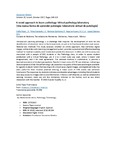| dc.creator | IRMA ELISA ERAÑA ROJAS;613488 | |
| dc.creator | JOSE EDUARDO PEREZ SAUCEDO;613863 | |
| dc.creator | ALVARO BARBOSA QUINTANA;271483 | |
| dc.creator | NANCY DE LOS ANGELES SEGURA AZUARA;818331 | |
| dc.creator | MILDRED VANESSA LOPEZ CABRERA;573940 | |
| dc.creator | IRMA ELISA ERAÑA ROJAS;613488 | es |
| dc.creator | JOSE EDUARDO PEREZ SAUCEDO;613863 | es |
| dc.creator | ALVARO BARBOSA QUINTANA;271483 | es |
| dc.creator | NANCY DE LOS ANGELES SEGURA AZUARA;818331 | es |
| dc.creator | MILDRED VANESSA LOPEZ CABRERA;573940 | es |
| dc.date | 2017 | |
| dc.date.accessioned | 2018-10-18T20:34:55Z | |
| dc.date.available | 2018-10-18T20:34:55Z | |
| dc.identifier.issn | 15751813 | |
| dc.identifier.doi | 10.1016/j.edumed.2016.08.004 | |
| dc.identifier.uri | http://hdl.handle.net/11285/630392 | |
| dc.description | Introduction Learning pathology is a challenge that requires the development of skills for the identification of abnormal states in the human body, as well as its functional disorders and causes. Material and methods This study assesses whether an online approach, that combines digital images, online slides and a learning management system, provides a practical and effective teaching method for medical students, both inside and outside the classroom. In 2015, an online survey was conducted with a sample of (83) students of the Pathology class, in order to assess student satisfaction with a Virtual Pathology Lab. A 1 to 5 Likert scale was used, where 1 meant total disagreement, and 5 for total agreement. The selected method is quantitative to provide a descriptive analysis of student perceptions. Results A mean score of 4.78 was obtained, indicating a clear acceptance of the Virtual Pathology Lab, based on the quality of the cases and images available. As regards students’ beliefs that learning with clinical cases, digital images, and digitalised slides has been useful for their medical practical training, a mean score of 4.48 media was achieved. Conclusions The responses by students indicate considerable advantages, including that all students have easy access to images and course information. It favours self-directed, as well as collaborative learning. However, there are still few limitations inherent to the format, such as less direct interaction with the teacher. © 2016 Elsevier España, S.L.U. | |
| dc.language | eng | |
| dc.language | spa | |
| dc.publisher | Fundacion Educacion Medica | |
| dc.relation | https://www.scopus.com/inward/record.uri?eid=2-s2.0-85002045828&doi=10.1016%2fj.edumed.2016.08.004&partnerID=40&md5=9b59a84ac9e6d3de09c73492617a2640 | |
| dc.relation | Investigadores | |
| dc.relation | Estudiantes | |
| dc.rights | info:eu-repo/semantics/openAccess | |
| dc.rights.uri | http://creativecommons.org/licenses/by-nc-nd/4.0 | |
| dc.source | Educacion Medica | |
| dc.subject.classification | 7 INGENIERÍA Y TECNOLOGÍA | |
| dc.title | A novel approach to learn pathology: Virtual pathology laboratory [Una nueva forma de aprender patología: laboratorio virtual de patología] | |
| dc.type | Artículo | |
| dc.identifier.volume | 18 | |
| dc.identifier.issue | 4 | |
| dc.identifier.startpage | 249 | |
| dc.identifier.endpage | 253 | |
| refterms.dateFOA | 2018-10-18T20:34:55Z | |

